
by Jessica Hughes | May 20, 2024 | Main Articles
by Jessica Hughes

The Hispanic Restaurant Association, or HRA, will be hosting its first farmers market in the parking lot of Infinity Park in Glendale on Saturdays starting May 25.
What better way to savor summer in the Cherry Creek Valley area than by visiting a local farmers market? The thriving farmers market scene has become a beloved summer tradition for locals and visitors alike. With an abundance of markets scattered throughout the area, these organic gatherings offer a unique opportunity to connect with local producers, savor the flavors of the region, and immerse oneself in the community.
A primary reason for the popularity of farmers markets is the access they provide to fresh, locally grown produce. Colorado’s rich agricultural heritage and diverse microclimates allow for a wide variety of fruits and vegetables to flourish, from juicy cherries and peaches in Palisade to crisp corn from Olathe and sweet melons from Rocky Ford. By purchasing directly from the farmers, consumers can not only enjoy the fresh taste and nutritional value of these harvested goods but also support the local economy and sustainable farming practices.
Beyond the abundance of produce, farmers markets offer a unique shopping experience that caters to a variety of tastes and interests. Artisanal baked goods, locally raised meats, handcrafted goods, and even fashion trucks and pop-up boutiques can be found at many
of these markets, creating a one-stop-shop for those seeking a curated and authentic shopping experience.
From the long-running Metro Denver Farmers’ Market, which has been operating for over 40 years, to newer additions like the People + Produce at Belleview Station and the Glendale Farmers Market, these events have become integral parts of the community fabric.
Moreover, these markets provide a platform for local chefs and culinary enthusiasts to showcase their talents. Many markets feature chef demonstrations, interactive cooking classes, and on-site food trucks, offering visitors a chance to learn from the experts and sample the flavors of the region transformed into delicious dishes.
Mark your calendars and prepare to fill your reusable bags at these can’t-miss farmers markets.
Glendale Farmers Market
When: Saturdays, May 25 – August 31,
8 a.m. – 1 p.m.
Where: Infinity Park, 4601 E Kentucky Ave., Glendale
New this year, discover Colorado’s vibrant culinary scene at the Glendale Farmers Market. In partnership with the Hispanic Restaurant Association, the City of Glendale, and the Greater Glendale Chamber of Commerce, this flavorful market features a unique fusion of locally sourced agriculture and culinary excellence. Discover fresh, locally grown fruits, vegetables, and meats alongside Chef Pablo’s Kitchen and an interactive Chef’s Table, where you can savor the bounty of Colorado transformed into exquisite dishes.
Colorado Fresh Markets (Cherry Creek)
When: Saturdays, May 4 – Oct. 12, 2024, 9 a.m. – 2 p.m.
Where: New this year, the market is on the east side of Cherry Creek Shopping Center, along South Steele Street near Macy’s
Located in the heart of Denver’s Cherry Creek neighborhood, the Colorado Fresh Markets mixes both fashion and farms. With local vendors selling homegrown produce and goods, plus fashion trucks and pop-up boutiques, it’s the perfect chance to stock up on seasonal fruits and veggies, plus the latest in fashion trends. Enjoy free parking when you get your ticket validated at the market. coloradofreshmarkets.com.
Urban Market at Denver Union Station
When: Five summer weekends starting June 1 – August 18, 2024, 12 – 6 p.m.
Where: Denver Union Station
(1701 Wynkoop St, Denver, CO 80202)
Spend your summer weekends in the heart of downtown Denver at the Urban Market, in Denver Union Station. Less of a farmers market and more of an artisan market, shoppers will find local arts and crafts sold directly by the artists, clothing, jewelry, antiques, and furniture, with some local produce mixed throughout.
Metro Denver Farmers Market
When: Saturdays, May 4 – Oct. 26, 2024,
8 a.m. – 2 p.m.
Where: The southeast parking lot at
Wadsworth Boulevard and
West Bowles Avenue, Littleton
What began over 40 years ago as a small market in downtown Denver in an Auraria campus parking lot, the Metro Denver Farmers Market is now Denver’s longest-running market and a favorite for shopping the freshest, local foods. Each week over 30 vendors offer a mix of produce from local generational farms, prepared foods from local food makers, and craft vendors.
City Park Esplanade Fresh Market
 When: Saturdays, May 4 – Oct. 26, 2024,
When: Saturdays, May 4 – Oct. 26, 2024,
from 8 a.m. – 1 p.m.
Where: 2551 E Colfax Ave., Denver
Working with local farmers and growers, the City Park Farmers Market recaptures the tradition of selling local produce and goods that are good for you and the economy. The family-friendly market brings live entertainment and a festive vibe all while enjoying breakfast, lunch, and brunch-prepared food options. Plus, with monthly chef demos by some of Denver’s favorite chefs, you’ll never run out of at-home meal ideas. cityparkfarmersmarket.com.
South Pearl Street Farmers Market
When: Sundays, May 5 – Nov. 10, 2024,
9 a.m. – 1 p.m.
Where: South Pearl Street, between Arkansas and Iowa, in Denver
The South Pearl Street Farmers Market sets up shop along the quaint South Pearl Street — home to Denver food favorites; Kaos Pizzeria and Sushi Den. Every Sunday from May to November, the street (between the 1400 and 1500 blocks) becomes an eclectic mix of local produce stands, handmade goods crafted by local artisans, food trucks, and live music for the entire family. southpearlstreet.com
 University Hills Farmers Market
University Hills Farmers Market
When: Saturdays, May 11 – Oct. 26, 2024,
9 a.m. – 1 p.m.
Where: University Hills Plaza,
2500 S. Colorado Blvd.
While smaller in size, the University Hills Farmers Market offers plenty of fresh finds and free parking for its shoppers. A prime shopping location in Denver since 1955, the University Hills Plaza hosts the weekly market featuring a variety of local produce, handmade goods, flowers and more. uhpla za.com.
 Highlands Square Farmers Market
Highlands Square Farmers Market
When: Sundays, May 19 – Oct. 13, 2024,
9 a.m. – 1 p.m.
Where: 32nd Ave & Lowell Blvd, Denver
The Highlands Square Farmers Market, one of Denver’s newest markets, offers a trendy twist with its market bar. Shoppers can enjoy a crafty concoction while shopping Colorado-grown produce, flowers, baked goods, and a variety of ready-to-eat foods, all while vibing to the sound of live music. highlandssquarefarmersmarket.com.
People + Produce at Belleview Station
When: Sundays, June 2 – Oct. 13, 2024,
9 a.m. – 1:30 p.m.
Where: Belleview Station, at the corner of I-25 and East Belleview Avenue, DTC
The People + Produce market is Denver’s newest farmers market serving Southeast Denver, Cherry Hills Village, Greenwood Village, and the DTC. The market will feature 50+ vendors each week, selling everything from farm fresh produce and baked goods to locally crafted artisan goods. Plus, with food trucks, fashion trucks, live music and a beer garden, it’s sure to be a fun time. Peopleandproducebvs.com.
Farmers markets are a great place to find fresh, locally sourced foods from Colorado farmers.
In addition to locally grown produce, many farmers markets sell other items such as fresh flowers.
City Park Farmers Market photos
The Cherry Creek Valley is home to a variety of farmers markets throughout the city.
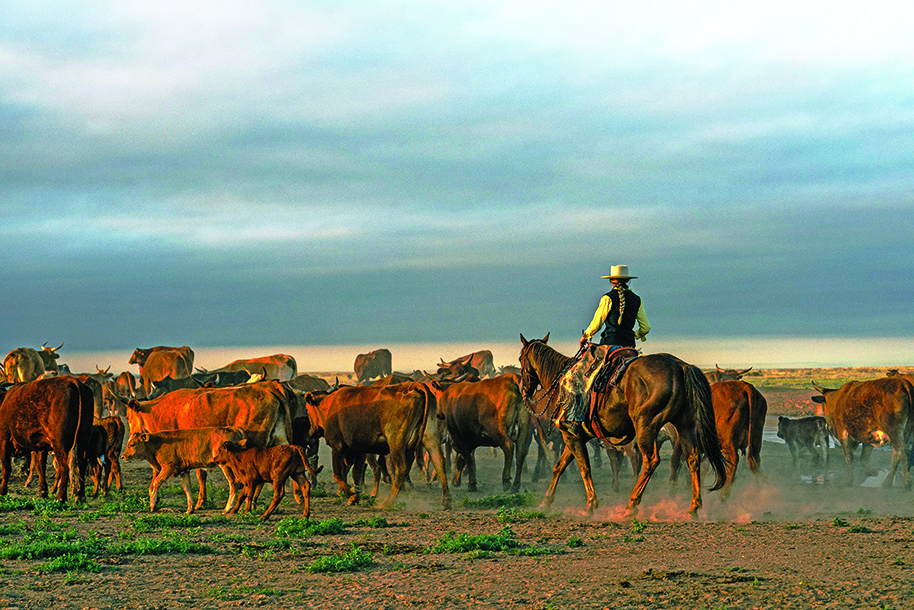
by Jessica Hughes | Apr 19, 2024 | Glendale City News
by Jessica Hughes
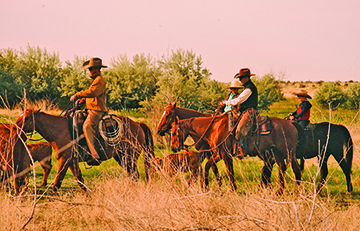
Ranching at Chico Basin Ranch. Photo credit: Ranchlands and Davey James Clark

Chico Basin Ranch. Photo credit: Ranchlands and Matt DeLorme
A recent decision by the Colorado Land Board to not renew a 25-year lease at Chico Basin Ranch has left a favorite Colorado family without a home for them or their cattle.
Located just southeast of Colorado Springs, the Chico Basin Ranch spans 86,000 acres of short-grass prairie and has been held in a trust for the good of Colorado’s K-12 schools. The land is leased and managed by Ranchlands, a family-ranching business run by Duke Phillips III and his children. They operate large-scale cattle and bison ranches in the American West and partner with conservation-minded owners to implement conservation programs that work alongside their ranching operations, all while preserving the ranching legacy.
The lease between the Colorado Land Board and the Phillips family business is due to expire at the end of this year. According to the Colorado Department of Natural Resources, “to prepare for the expiration of the lease, the State Land Board evaluated different leasing scenarios that would achieve the goals of the School Trust to earn revenue and maintain exceptional stewardship.”

The Phillips Family: Duke Phillips IV, Madi Phillips, Duke Phillips III, and Tess Leach. Photo credit: Parker Fitzgerald and Ranchlands
To evaluate available options, the agency hosted 11 public meetings over 18 months and issued a competitive request for proposals. In November 2023, the Colorado Land Board decided to lease the land to another ranching operation that outbid Ranchlands by a hefty amount, despite Phillips and his family pleading with the board to consider more than just money for the new 10-year lease.
In this case, money spoke the loudest and the Phillips family was out-bid by a lot. Ranchlands offered 25% over asking and the new lessee offered 75% over.
“We offered a fair and consistent revenue for the renewed lease,” says Tess Leach, Duke’s daughter, and Head of Business Development at Ranchlands. “We thought that they would value our operations and the impact we had on the community over money.”
In this situation, it appears that money won, begging the question, what is the purpose of the Colorado State Land Board? As the second-largest landowner in Colorado, with 2.8 million surface acres and 4.0 million mineral estate acres, the board states its mission is “to produce reasonable and consistent income over time, and to provide sound stewardship of the state trust assets.”
Thus, the board has a mission to not accept the highest bid for a lease, which they just did, or accept profitable, yet damaging uses for the land it owns. State lands are leased for many different reasons, some of which Ranchlands won the bid for 24 years ago, including recreation, cattle grazing, and hospitality.
During their long-standing lease, Ranchlands was proud to provide a variety of educational programs, recreational activities, ranch stays, art shows, concerts, creative writing workshops, roping, and photography classes at Chico Basin Ranch for the community to enjoy. And to help the next generations of ranchers take hold, the Phillips also offered an apprenticeship program that helped train young ranchers with real-world experience, plus learn about ranching and conservation.
One of Ranchland’s most successful programs is the bird-banding station that they instituted — the oldest in Colorado. Because the Chico Basin Ranch is one of the largest uninterrupted stretches of prairie left in the United States, the ranch is known as one of the prime locations in Colorado for birding. In partnership with the Audubon Society and Bird Conservancy of the Rockies, the ranch maintains a bird banding station where visiting biologists band hundreds of migratory birds and is open to the visiting public to help assist in this process.
However, these programs face an uncertain future as the lease nears its expiration. According to Phillips, the new lease agreement lacks any provisions for public recreational access, implying that the land will be off-limits to the community starting in 2025. This reality threatens to dismantle the programs and initiatives that Phillips and his family have painstakingly cultivated over the years.
Phillips describes this as a huge loss for the Front Range of Colorado. “We have always had an open gate policy for people to come in and look at the ranch and enjoy it with hiking, tours, and other activities,” says Phillips. “Our biggest legacy at the Chico, is the community we have built. This is what we are most sad to be leaving behind.”
“I don’t think the land board values the community component as much as they do about money,” says Duke. “If we continue to value money over community, ranching will become a thing of the past if we don’t recognize the importance of conservation and community.”
Despite this devastating loss, the Phillips family is determined to continue its efforts to bridge the divide between rural and city communities. “People are becoming more and more isolated from nature,” says Phillips. “It has become a focus for us to try and bridge the gap between urban and rural communities.” Because of this, Ranchlands has initiated The Collective, a new organization focusing on developing a model, that sees ranching as an alternative to large-scale conservation in the U.S. The first-of-its-kind, a Collective membership will grant those who join a deeper access to Ranchlands and their mission of perpetuating ranching into the future with exclusive events, conversations, and experiences on working landscapes.
“This will only happen if we do it together,” says Phillips. “We can’t do it alone as ranchers and we will all have to come together to make this happen.”
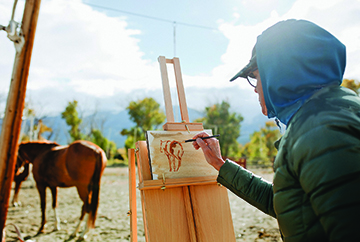
Art programs at Chico Basin Ranch. Photo credit: Ranchlands and Avery Sass
Phillips and his family are on a mission to create a grassroots movement where the short-term gain of money isn’t the objective, and the long-term vision for the land is. “The whole idea of land being treated as a commodity that is bought and sold, is a foreign concept to someone like me as someone who lives on it, tries to take care of it, and use it,” says Phillips. “We want to start a revolution with The Collective that protects the land through ranching and not money and transactions.”
The Phillips family will soon leave Colorado and make a new home at Paint Rock Canyon on the west side of the Bighorn Mountains, in Wyoming. But the biggest challenge right now is finding another ranch to which they can move their cattle. While the family’s challenges are far from over, they are hopeful for the next chapter and the continued ability to uphold and share the legacy of ranching with the next generation.
“Life gives you a lot of bends and turns in it. We’re going to take the lumps and move forward and see where we land,” says Phillips. “But we are looking at the other side of it all and are thankful to have lived there. We are very appreciative of our time at Chico Basin Ranch.”
For more information, visit them at Ranchlands.com.
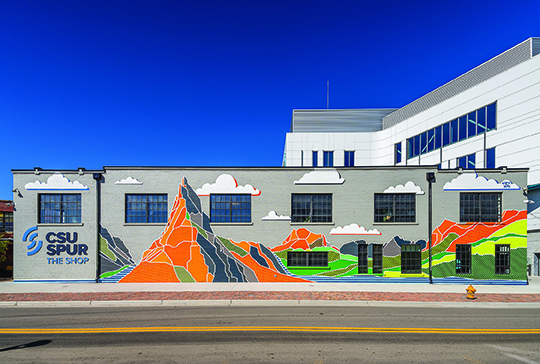
by Jessica Hughes | Feb 19, 2024 | General Featured
by Jessica Hughes
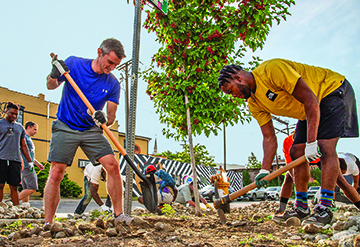
Green Dot Coalition was awarded a grant of $10,000 through the RiNo Art District Social Impact Grants program.
2024 is shaping up to be a good year for the latest recipients of the RiNo Art District’s Social Impact Grants, which recently awarded an amount of $75,000 — the program’s largest amount to date.
While most people know the RiNo Art District for its extensive collection of mural art and the newest annual art festival, Denver Walls, the district also plays a big role in supporting its local artists, businesses, and community through the RiNo Business Improvement District (BID).
The Social Impact Grant program first became available to local organizations in Five Points, Globeville, Elyria-Swansea, and Cole in 2020 after the murder of George Floyd. “We wanted to do something more impactful and to allocate money to organizations doing the hard work in the community,” says Alye Sharp, Deputy Director for RiNo Art District.

Curecanti Spur, mural by Lindz and Lamb at CSU Spur Campus Denver, CO.
To date, the organization has awarded a total of $225,000. The RiNo BID has additionally committed to increasing funding for the Social Impact Grants program every year.
“There were so many incredible organizations nominated this year addressing everything from social justice and food scarcity, to homelessness and youth arts education,” said Sharp. “We are so appreciative of the review committee’s passion for identifying and advocating for these organizations and appreciate our BID’s commitment to directing RiNo’s collective resources towards this important work in our community.”
Among the recipients of this grant are CIRCLE, EGS + Partners, Green Dot, Mo Betta, The People’s Pickle, and Youth Empowerment Broadcasting Organization (YEBO Media), who will each receive $10,000 to support community members in the five historic neighborhoods. Birdseed Collective will receive $15,000 to support their mission of educating and empowering disadvantaged and under-resourced individuals throughout the Denver area through food delivery, environmental equity work, youth-focused projects and events, art accessibility, work with immigrant communities, and more.
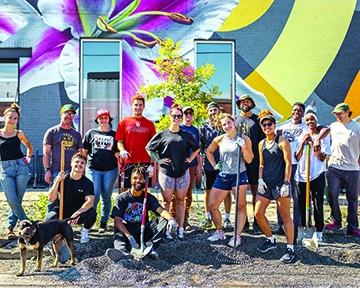
Green Dot Coalition is an equity-focused placemaking organization working to translate community vision into green spaces, practices, and policies.
With the goal of placing equity at the center of grant-making decisions, recipients are nominated by a diverse committee of local community members, this year led by Denver City Council District 9 Councilman Darrell Watson.
“RiNo’s Social Impact Grants allow us to amplify and celebrate the extraordinary work taking place every day in our District to address some of our most pressing social issues,” said Councilman Watson. “These grants are an investment in a city that works for everyone, and I’m excited to see how the selected organizations leverage their funds in service of their neighborhoods and their communities.”
Sharp also emphasized that they wanted this grant program to be an easy process for everyone to apply. “It was important that this money be unrestricted. Being able to directly write a check for the recipients is super important.”
Founded by the local artists Tracy Weil and Jill Hadley-Hooper, the RiNo Art District, a 501(c)(6) nonprofit arts organization, was created to help foster a thriving, welcoming, and creative community of artists, residents, and businesses.
As the area’s growth has surged over the years, so did the art district. “Big shifts happened in 2014 when the community came together and wanted to retain some of that creative control of how the district improved,” says Sharp.
Today, the district overlays five historical neighborhoods: Globeville, Elyria, Swansea, Five Points, and Cole. Over the last decade, RiNo Art District has helped form both a Business Improvement District (BID) and General Improvement District (GID) and a community arts educational nonprofit (Keep RiNo Wild) to support the local community.
“It’s a collaborative community of small businesses including galleries and studios, plus an incredible amount of public art,” says Sharp. “There are quite a few working artists in the district with studio space and galleries. It is a place that art is being made every day.”
“We extend our deep gratitude to the RiNo Art District for their generous support to EGS & Partners,” said Sandra Ruiz Parrilla, CEO of EGS & Partners. “This fund will not only strengthen our mission to improve our neighborhoods and offer vital mental health art therapy programs, but will also allow us to grow and get even closer to the community, effectively engaging residents in Elyria-Swansea and Globeville neighborhoods. Together, we will move forward toward promoting environmental and social justice, promoting health, and building a stronger, healthier community. Thank you for being a valued partner in our shared mission!”
To learn more, visit the RiNo Art District at rinoartistrict.org.
Photos provided by: RiNo Art District
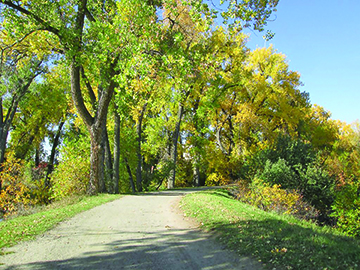
by Jessica Hughes | Jan 19, 2024 | Main Articles
by Jessica Hughes
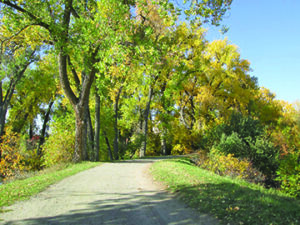
The High Line Canal Trail crosses five different major counties in the Denver Metro Area.
The High Line Canal is a man-made waterway begun in 1881 for the purpose of irrigating land in Denver and eastward. Beginning at a diversion dam off the South Platte 1.8 miles above the mouth of Watterton Canyon it runs a meandering 71 miles through Douglas, Arapahoe, Denver, and Adams Counties and ending near Green Valley Ranch. It is based on the “high line principal” of following the contours of the land to allow the water to flow by gravity with a minimal drop in elevation per mile. As a result, the Canal has many twists and turns.
The Canal was never a very efficient vehicle for providing water for irrigation and it no longer does so. But over the years it has become a major source of recreation. A maintenance road ran aside the High Line Canal to assist in making repairs to the Canal and is now called the High Line Canal Trail. It is now open to all non-motorized traffic. Parts of the trail are dirt while others are concreted.
The High Line Canal I-70 construction project, which began one year ago, is slated to be finished in early 2024. The City of Aurora in collaboration with American Civil Constructors, will close the longest gap (three miles) of the 71-mile High Line Canal Trail from Colfax Ave. to the trail north of I-70 when the project is complete.
This new section of the trail will connect Northeast Denver to the rest of the Canal with a continuous eight-foot-wide concrete trail, two pedestrian bridges, including the I-70 overpass, another to cross the Canal at Smith Rd., upgraded railroad crossing for pedestrians and cyclist safety, and more.
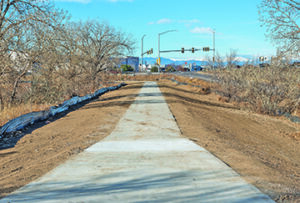
The new three-mile section of the High Line Canal Trail bridges the gap between Colfax Ave. to the north of I-70 with an eight-foot-wide concrete trail.
“When complete this project will provide close-to-home, accessible recreation opportunities to the diverse population that use this section,” says Harriett Crittenden LaMair, the High Line Conservancy Executive Director.
The High Line Canal Conservancy was founded in 2014 to permanently protect the 71-mile High Line Canal and unify all partners to implement The Plan for the High Line Canal. Partners include Denver Water, along with support of 11 jurisdictions where the Canal is located, including the City of Aurora — the lead partner for the I-70 project.
The High Line Canal Trail twists and turns through the most populated areas of Colorado, crossing multiple and varied communities in the Metro area. With over 350,000 residents living within one mile of the Canal and approximately one million people using the trail annually, efforts to improve the trail system are more important than ever.
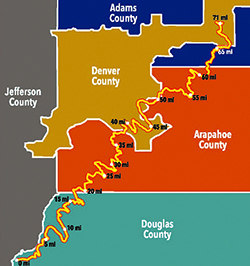 Since the 1920s, the Canal has been owned by Denver Water as a part of Denver’s water delivery system since the 1880s. Over the last 100+ years, the Canal’s evolution has gone from utilitarian efforts of conveying water, to a community-wide recreational and environmental hub for locals and visitors alike.
Since the 1920s, the Canal has been owned by Denver Water as a part of Denver’s water delivery system since the 1880s. Over the last 100+ years, the Canal’s evolution has gone from utilitarian efforts of conveying water, to a community-wide recreational and environmental hub for locals and visitors alike.
There will also be a major focus on improvements to the northern 28 miles of the Canal due to historic underinvestment. “This area is also some of the most diverse communities in the state,” says Crittenden LaMair. “With some of these improvements we strive to bring more equity to outdoor access.”
To ensure adjacent communities were aligned, the conservancy led with a community-first mindset, working with anyone who wanted to be involved in the planning and development of future projects. “We worked with over 10,000 people who wanted to get involved with the design improvements of the Canal’s northern sections,” says Crittenden LaMair.

The new I-70 overpass of the High Line Canal Trail is expected to be complete in early 2024.
She also explains an important part of the project is to create trail improvements through a community-centered design process. “There are 28 schools within a quarter of a mile from the High Line Canal,” says Crittenden LaMair. “The Canal is an important community resource for moving and we want to encourage kids to use it for walking to and from the elementary schools.” But for the Conservancy, it isn’t only about walkability scores, it’s also about creating community activation zones where the community can come together.
“For example, there are proposed improvements for an outdoor classroom along the Canal by Green Valley Ranch’s Marrama Elementary school,” says Crittenden LaMair. “Another example includes Aurora’s Laredo Highline neighborhood, the Grandy Ditch Open Space, where there are proposed plans to include bike racks, a shade structure, and natural elements for neighbors to enjoy.”
Federal funds were granted to the City of Aurora for the I-70 project through the Denver Regional Council of Governments, with the city using capital improvement funding as a match. Additional funding came from the Conservation Trust Fund, Adams County Open Space Grant, and Adams County Open Space Tax Shareback with a total of $9.4 million invested in the project.
Overall, funding for the conservancy includes both public and private outlets — including all the conservancy’s jurisdictional partners, regional and national foundations, corporate partners, and over 2,500 annual private donors.
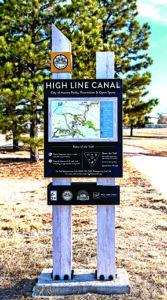
New trail signage anchors the newest section of the High Line Canal Trail.
“We raise over 60% of our annual operating budget in November and December, in particular on Colorado Gives Day,” says Crittenden LaMair. “These are critical funds that keep our organization afloat and help to support all of the work that we do.” There are several ways in which individuals can help support the conservancy through bench and tree adoptions as gifts to commemorate someone special, monthly donations, corporate sponsorships, and volunteering opportunities.
Beyond the I-70 project, what does the future hold for the High Line Canal Trail? Crittenden LaMair says there are plans for enhancements to make the trail safer and more enjoyable for everyone, plus, ongoing ecological restoration and maintenance for recreational uses across all 71 miles.
“This year we will have more exciting updates about next steps in protecting the Canal for future generations,” says Crittenden LaMair. “It’s important to continue improvement along the Canal because it’s a recreation hub with easy access to the outdoors in the middle of the city, a place where youth can connect with nature, free outdoor recreation for local communities, build biodiversity and ecological health in urban areas, and more. It really is a staple for those living in the metro area.”
Learn more about the High Line Canal Conservancy at highlinecanal.org.
Photos by Jessica Hughes

by Jessica Hughes | Nov 16, 2023 | General Featured
by Jessica Hughes
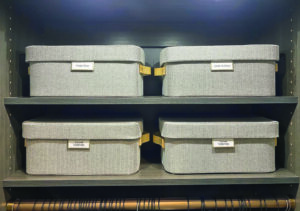
Labeling your bins takes the guesswork out of where things go.
Oftentimes, the holiday season can feel overwhelming with the in-laws in town, additional obligations, finding the perfect gift, and then wrapping it. With so much going on, being organized can make a world of difference and ease the stress of “what box did I put the Christmas lights in last year.” Decluttering and organizing can help you focus on life’s other obligations this time of year. But where does one start?
Christina DesAuguste, founder of The Organizing Company — a professional organizing company that helps people organize their “stuff” in a functional, good-looking way, says to start with a method. “For those starting the process of organizing, it is best to start with a method, rather than “tips and tricks.”
During the holiday season, one of the biggest mistakes DesAuguste says she sees often is people frantically throwing things in their hamper or some other “catch all” and stick it in the closet somewhere right before friends and family arrive. “It’s best to try and not hide your mess before company comes over,” says DesAuguste. “Instead, try to come up with a method or process that sets you up for success.”
One method DesAuguste suggests when bringing out decorations for the season, is to place your non-holiday items in the holiday bins you pulled out from storage. This way, when the holidays are over, you can easily make the swap.

Christina DesAuguste gets organized with one of her Hilltop clients in Denver.
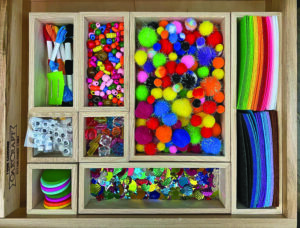
Organization not only reduces stress, but it looks good too.
“Make a decision about how you store your holiday decorations,” says DesAuguste. “You can do it by room or by category. But try not to do a “free for all storage” and take the time to be methodical.”
While DesAuguste emphasizes there is no one size fits all for organization items everyone must have, she does mention a few things she thinks everyone can benefit from. “A label-maker is huge help in getting things back where they belong. It helps eliminate the “where does this go?” question.”
Another item she strongly suggests might be one that surprises you. “A three-step stool is great to have handy,” says DesAuguste. “It sets you up for success by having easy access to things, so you put items back in their right place.”
In terms of decluttering your space to make room for all your holiday demands, DesAuguste says she is a big fan of having children go through their toys before gift-giving season. “Choose things they are ready to part with and donate. That way when new gifts come there is room for them.”
But taking away your kid’s toys might prove challenging, so starting with big bulky items that don’t have any meaning is another option. Think of items like excess small appliances, comforters you no longer use, or cleaning supplies you don’t use anymore. One other item that is less obvious but easy to discard is old paint cans.
Often forgotten about, paint cans clutter basements, garages, and crawl spaces,” says Kevin Lynch, the Program Manager for PaintCare Colorado. “Free up some of that space by taking cans of paint to one of our local drop-off sites or using the PaintCare Door-to-Door service to make room to store presents in advance of the holidays.”
PaintCare is the paint recycling program in Colorado for consumers and businesses to drop off their unwanted paint, no matter the brand, for free reuse or recycling. With more than 160 participating drop-off locations, most locations are at paint and hardware stores.
So, why worry about getting rid of your old paint cans, aside from decluttering your space? “The older that paint gets the less usable it is,” says Lynch. “Unused cans of paint can become rusty and leaky from moisture, especially in our fluctuating Colorado climate.”
Drop-off is available year-round during the retail location’s regular business hours. And if you don’t have the ability to visit one of the drop off locations, the Denver area is fortunate to have a PaintCare home paint pickup program, called Door-to-Door Service, for households with more than 10 gallons of leftover paint, stain, and varnish. There is no charge for the pickup service; the cost is included on the sale of all new paint purchased, which is how the PaintCare program is funded.
If you’re not ready for a full-blow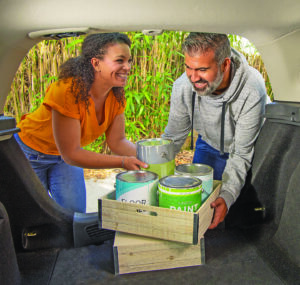 n organization method, DesAuguste offers a few organizing “hacks” to help get you started. “Build a “10-minute tidy up” into your daily routine. Having this time to make sure things get back to their proper homes is a great way to prevent the overwhelm that comes with huge piles of mail/laundry/dishes, or a wild playroom.” She recommends doing this after dinner and before sitting down to relax. “But whatever time of day you and your family can be consistent is great,” says DesAuguste.
n organization method, DesAuguste offers a few organizing “hacks” to help get you started. “Build a “10-minute tidy up” into your daily routine. Having this time to make sure things get back to their proper homes is a great way to prevent the overwhelm that comes with huge piles of mail/laundry/dishes, or a wild playroom.” She recommends doing this after dinner and before sitting down to relax. “But whatever time of day you and your family can be consistent is great,” says DesAuguste.
Another trick she mentions is to assign tasks to a certain day of the week. “For example, Mom’s laundry day is Monday, Tommy’s is Tuesday, and Suzie’s is Wednesday,” says DesAuguste. “Have a day of the week you open your mail rather than trying to open and deal with it while you’re carrying in groceries and unpacking kids’ backpacks- it just ends up in a pile somewhere never dealt with.”
She also suggests that until you are ready to get your house fully organized you can designate a day of the week that you organize. “Build time into your routine for things like this so they are more likely to get done.”
If you’re having a hard time starting the process of organizing and decluttering, Des Auguste says to simply start with your why in mind. “It helps to know why and deciding that it’s worth it is important to getting started.” Learn to organize anything in less than 10 minutes with Morton’s free video and guide at theorganizingco.com.


 When: Saturdays, May 4 – Oct. 26, 2024,
When: Saturdays, May 4 – Oct. 26, 2024, University Hills Farmers Market
University Hills Farmers Market Highlands Square Farmers Market
Highlands Square Farmers Market


















